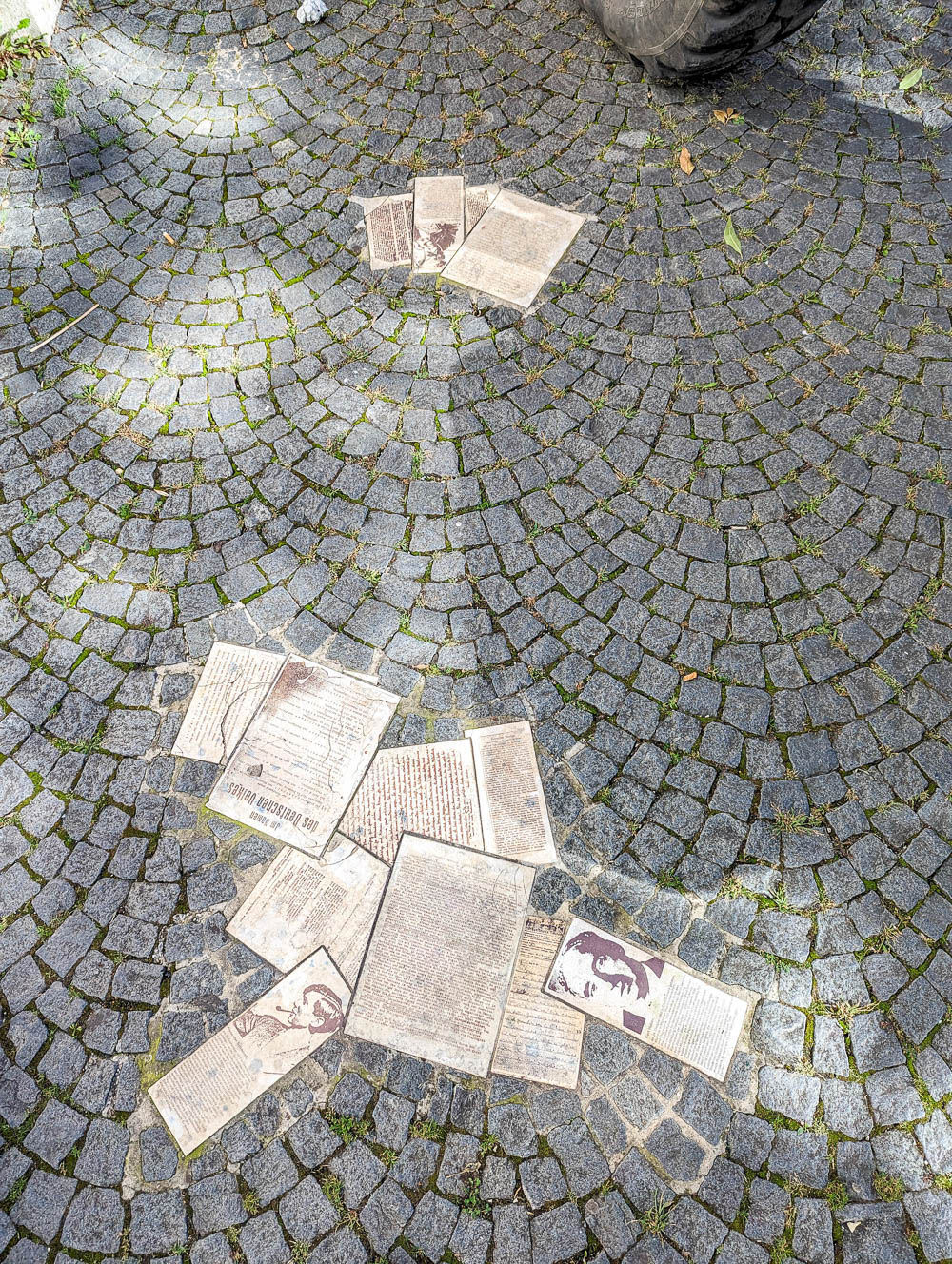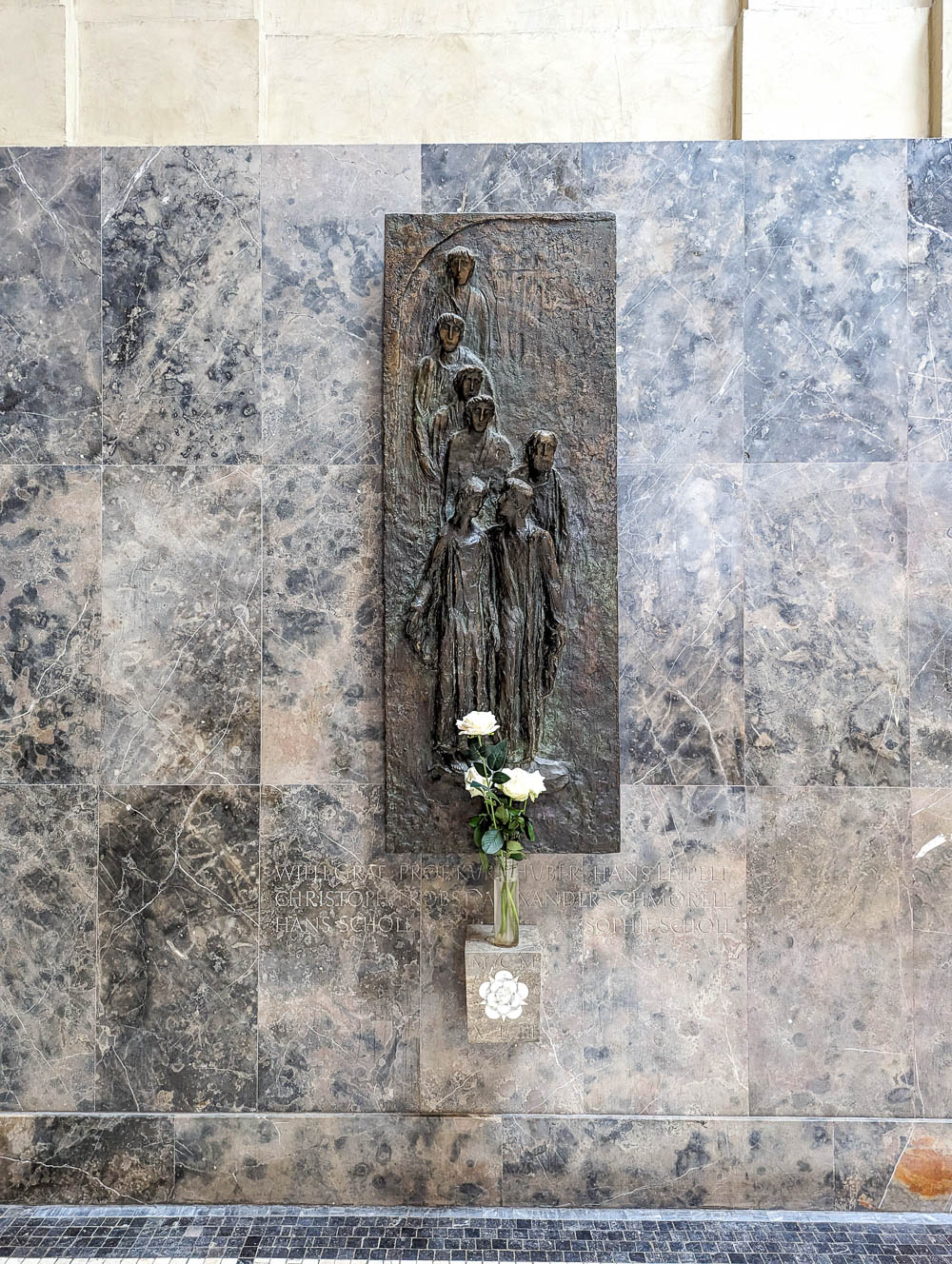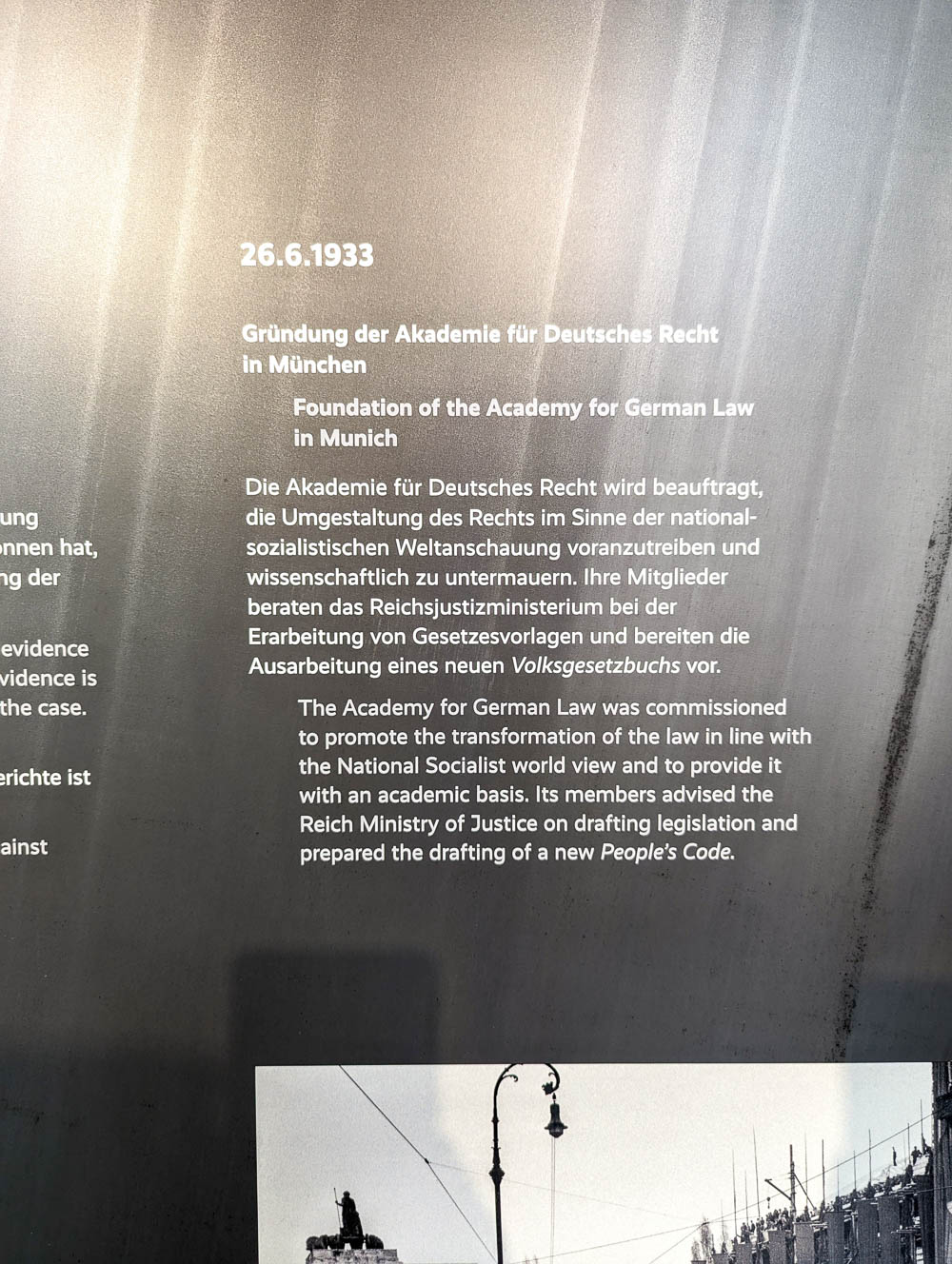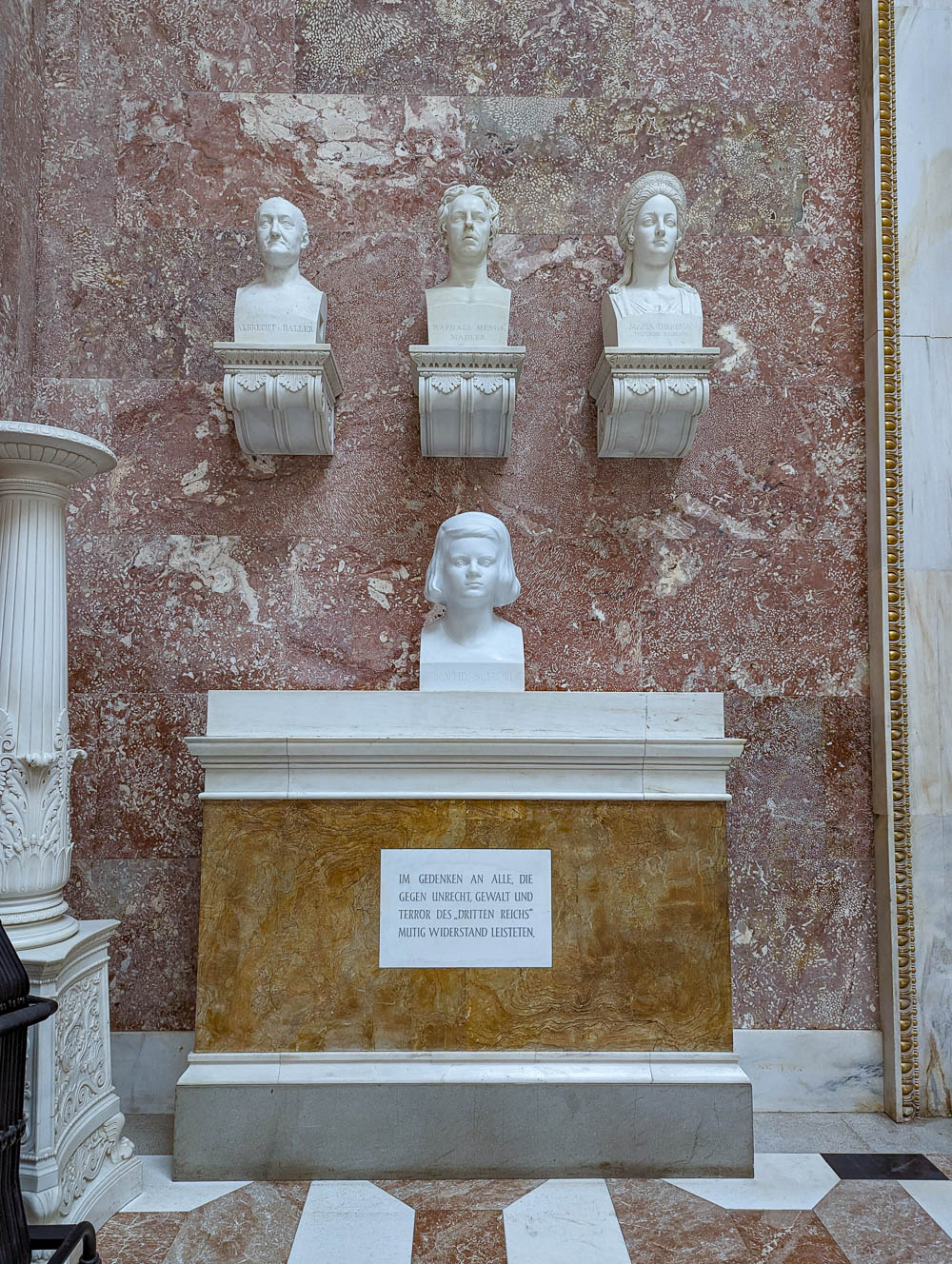During the war years here in Munich, Germany—birthplace of the Nazi Party—it wasn’t often that residents spoke out about the atrocities they’d witnessed. But in 1942, a group of local university students founded the “White Rose,” a resistance movement to fight back against Nazism.
Today, the White Rose isn’t as well-known as other resistance movements like the French Resistance or those behind the Warsaw Uprising, but it’s still an important and meaningful piece of history worth learning about.
Here in Munich, there are several places where you can learn more about this brave group of students and also pay your respects. This post will point the way.

What was the White Rose Movement?
The White Rose movement was a student-led resistance group formed in Munich, Germany to fight back against Nazi genocidal policies. It was founded in 1942 by a local university student named Hans Scholl who recruited his sister, his professor, and three other students.
The White Rose’s main goal was to persuade others to stand-up to the Nazi regime. To do so, they focused on writing, printing, and distributing pamphlets around Munich. These leaflets called out the Nazi regime for its genocidal policies and practices, called on the people of Munich to rise up, and advocated for sabotage of industries critical to the war effort. (They even advised readers on how to do so.)
The White Rose published six leaflets in total and were able to distribute around 15,000 copies of them in and around Munich, and even to several cities outside of Munich thanks to a loyal support network. (Christoph Probst had a draft of a seventh pamphlet on him when he was arrested.)
A copy of their sixth and final published leaflet was smuggled out of Germany, re-published in several Allied countries, and even dropped into Germany by the British RAF a few months later for all to read.

Check out the many other worthwhile historic sites here in my full guide to Munich’s World War II sites.
Why ‘White Rose’?
Several theories exist as to why the group named themselves the “White Rose.” Hans Scholl intentionally beat around the bush when asked about this during interrogation, so the name’s true origin isn’t known.
Some say it probably came from a poem or a banned book with the same title, but Hans Scholl claimed it to be an arbitrary choice that just sounded good. While I’m sure that isn’t true, we’ll just have to live with not knowing.

Who all was involved with the White Rose resistance group?
The White Rose movement was comprised of five students from Munich’s Ludwig-Maximillian University and one professor. They were:
Hans Scholl (23), White Rose founder
Hans was a former member of the Hitler Youth and participant in Nazi Party rallies who soon became disillusioned to Nazi policies. He was drafted into the Wehrmacht and served as a medic in both France and the Eastern Front. His experiences in the East and his increasing knowledge of Nazi mass murder kickstarted his anti-Nazi campaign.
Alexander Schmorell (25), White Rose co-founder
Schmorell was born in Russia but moved to Munich early on. He joined the Wehrmacht in 1937 but refused to pledge his loyalty to Adolf Hitler and even begged to be relieved of duty. For whatever reason, he was never punished for this and was allowed to continue with his military service. He met Hans Scholl shortly after returning from service.
Sophie Scholl (21), Hans Scholl’s sister
Sophie joined later but quickly became the group’s leading member. Before she could attend university, she was forced to serve in the military-like National Labor Service where her anti-Nazi sentiments grew.

Christoph Probst (22), White Rose member
Probst attended a Nazi-focused boarding school and served in the Luftwaffe right out of high school. He was a long-time friend and classmate of Schmorell who recruited him to the White Rose. Probst was already married with three kids at the time.
Willi Graf (24), White Rose member
As a child, Graf was a member of several banned Catholic youth groups known for their anti-Nazi teachings. Though he was forced to join the Hitler Youth, he never embraced it and actively resisted his participation. He was arrested in 1938 for his participation in another banned youth league and served time in prison. This only fueled the fire of his Nazi hate.
Kurt Huber (48) University professor and White Rose member
Huber was a psychology and music professor at Ludwig-Maximillian University. He was a member of the Nazi Party, until the stories he heard from his students who’d returned from the Eastern front changed his mind.

What happened to the White Rose movement?
The six members of the White Rose movement, having previously operated in secret, were ratted out by the university’s janitor who witnessed them distributing the pamphlets around campus. (Specifically, when Sophie pushed a stack of them off an upper floor into the University’s main atrium.)
Hans and Sophie were arrested immediately; Christoph Probst was arrested two days later. They were viciously interrogated, given a hasty “trial,” and all sentenced to death. The three of them were executed by guillotine on the same day—February 22, 1943.
Willi Graf was arrested on February 18th; Alexander Schmorell on February 24th; and Professor Kurt Huber on February 26th. They were tried together in April 1943 and all sentenced to death. Schmorell and Huber were executed on July 13th. Graf was held and tortured to give up more White Rose members, which he never did. He was executed on October 12.

Hans Leipelt and Marie-Luise Jahn
Several other people were arrested for their connections to the White Rose movement or for their participation in distributing the pamphlets. Eleven of them were sentenced to prison, many were acquitted for lack of evidence, several others never made it to trial due to the Allies’ arrival.
One more—Hans Leipelt—was executed. After Hans and Sophie’s executions, Leipelt obtained a copy of the sixth pamphlet. Together with his girlfriend Marie-Luise Jahn, they typed up even more copies and distributed them around their home of Hamburg. They also began collecting money for Professor Huber’s widow.
The two were arrested in late 1943. Leipelt was executed by guillotine on January 29, 1945 and Jahn was sentenced to 12 years in a hard labor prison. She was liberated a year and a half into her sentence and went on to become a founding member of the White Rose Foundation in 1987. She served as an executive board member until 2002 and passed away in 2010.

Where to learn about the White Rose?
Because the White Rose acted mainly within Munich, this is where you’ll be able to find out the most about them. However, there are a few places outside of Munich (but still in Germany) where you can also find references to them. This post will explain all of those; read on!
There’s also a White Rose off-Broadway musical, believe it or not. I haven’t seen it but it’s apparently pretty good. Each night after the show they have a free special event – interviews with historians, Holocaust survivors, and more. (It’s current run just ended, but perhaps it will continue elsewhere.)

White Rose museums & monuments in Munich
Though the White Rose resistance group is little-known outside of Germany, their contributions and sacrifices live on in Munich. There are several places here where you can still learn about these brave students. Add the following sites to your next Munich itinerary:
Map of White Rose sites
This map contains all the sites associated with the White Rose movement that I mention in this post. To save this map: Click on the star ⭑ next to the map’s title to save in your Google Maps. To use this map: When you get to Munich, open Google Maps on your phone, click “Saved” at the bottom, then click “Maps.”
While in Munich, you should definitely take a half-day trip out to Dachau Concentration Camp. Everything you need to know is in that link.

1. White Rose Exhibition & Courtroom at the Justizpalast
Munich’s Justizpalast is located right in the center of the city, just a block or so from both Karlsplatz and the main train station (Hauptbahnhof). Today, it houses the Bavarian Ministry of Justice and the Regional Court I of Munich.
But from 1934 until the end of the war, it was the home of the “People’s Court”—a kind of Nazi special court that tried those accused of criticizing the Nazi state. They held sped-up trials and doled out death sentences for even mild offenses. (To the surprise of no one, I’m sure.)
On February 18th, 1943, it was here in the Justizpalast that court officials tried Sophie and Hans Scholl and Christoph Probst and sentenced them to death. The later trials of the others were also held here in the main courtroom, in what is now called White Rose Hall.

White Rose permanent exhibition
Today in the Munich Justizpalast you can visit the permanent White Rose exhibition which is one of the most fascinating World War II exhibits I’ve visited anywhere. (Information is presented in both German and English.)
Not only does this exhibit explain the events surrounding the White Rose movement, but it also details in depth (but an easy-to-understand depth) the history of Nazi “law and order.” It chronicles the evolution of Nazi “justice” and how Germany fell so far, so fast from democracy.



One of the biggest things I took away from my WWII master’s degree program was that the Holocaust was a completely legal event. That is to say, those in power at the time (Nazis) changed the laws in such a way that benefitted and helped catalyze their goals. This exhibit explains exactly how they did that.
Additionally, you can also tour the very courtroom where the White Rose trials were held. You can learn more about each of the important figures involved—the members on trial as well as the presiding officials and other scum of the earth.
Recommended reading: If this topic interests you, you may also enjoy the book Holocaust, Genocide, and the Law by Michael Bazyler. It’s one of the most eye-opening, in my opinion.

Visitor information
For visiting the White Rose exhibit and courtroom, here’s what you need to know:
- Where to find it: At the Munich Justizpalast, Prielmayerstraße 7, Hall 253, on the second level
- Open hours: As of April 2024, the exhibit is open Mondays-Thursdays from 9am-3pm and on Fridays from 9am-2pm.
- Admission: Free
- Important info: Note that you’ll have to go through metal detectors and submit your belongings for screening in order to enter the building. More info here.
When I visited in September 2023, I was the only visitor in the whole building. The entire exhibit took me around 30-40 minutes to visit.

2. White Rose Memorial Exhibition at LMU
In the main atrium at Munich’s Ludwig-Maximillian University you’ll find the permanent White Rose Memorial Exhibition. This small museum exists in the very atrium where the Scholls distributed the last of the White Rose pamphlets.
This museum focuses wholly on the White Rose movement—its beginnings and motivations, its members, and its fate. It covers the group’s resistance activities and the contents of all six of its leaflets. The interactive displays are in both German and English.
This exhibition is referred to as DenkStätte Weiße Rose in German.

Visitor information
For visiting the White Rose exhibition at LMU, here’s what you need to know:
- Where to find it: In the atrium at Ludwig-Maximillian University, Geschwister-Scholl-Platz 1, behind the wall opposite the stairs, go around the right side. You can take either the U3 or U6 to the “Universität” stop.
- Open hours: As of 2024, this museum is open Mondays-Fridays from 10:30am-4:30pm and on Saturdays from 11:30am-4pm.
- Admission: Free
- More info: Here


3. Memorials at Ludwig-Maximillian University
Also at Ludwig-Maximillian University you’ll find several memorials to the White Rose movement scattered around. While you’re there, look for:
The scattered leaflets memorial
Outside the entrance to the LMU atrium you’ll find a subtle memorial on the ground that represents the White Rose’s scattered leaflets. Some of them are copies of the pamphlets and some describe members of the group. This memorial was created by artist Robert Schmidt-Matt and was installed in 1990.


Bronze relief sculpture of the group
Inside the atrium, on the left side, is a bronze relief sculpture that depicts the seven executed White Rose members. Their names are inscribed on the marble wall underneath and a block picturing a stylized white rose sticks out from the wall. A small vase with white roses sits on this block. This memorial was sculpted by artist Lothar Dietz and installed in 1958.

Bust of Sophie Scholl
On the right side of the same wall (near the entrance to the White Rose exhibition) is a bronze bust of Sophie Scholl atop a white block. It was donated by artist Nicolai Tregor in 2005.
The White Rose Organ
When coming down the steps into the atrium, turn around and you’ll see the White Rose Organ high above you. This organ was installed in 1960 as an “acoustic monument” to the White Rose movement. After being restored in 2013, it’s once again being used for commemorative concerts.


4. NS Documentation Center
Munich’s NS-Dokumentationszentrum (the National Socialism Documentation Center) is a fantastic museum all about the formation and history of National Socialism and the Nazi Party. It sits at the location of the former Nazi headquarters and answers all the questions you’ve ever had about how in the world the Holocaust was able to happen.
Naturally, this is another great place to learn about the White Rose movement. For more on this museum, check out my full post on why you should visit Munich’s NS Documentation Center.

Visitor information
- Where to find it: Max-Mannheimer-Platz 1, just down the street from Königsplatz
- Open hours: Tuesdays – Sundays from 10am-7pm, and all public holidays (even if they fall on a Monday)
- Admission: Free
- More info: Here
5. White Rose memorial at the Hofgarten
Just north of Munich’s Old Town and right behind the popular Residenz Museum is the Hofgarten, a beautiful urban green space. Follow the walking paths to the northeast corner and you’ll find the White Rose Memorial.
This memorial, represented by a large black granite cube, was created by artist Leo Kornbrust and was installed in 1996. The front and back sides of the block are inscribed with quotes (in German). The front: with quotes taken from the White Rose leaflets. The back: with quotes from Josef Hufnagel and General Field Marshal Erwin von Witzleben.

Josef Hufnagel was a farmer the Nazi regime executed on June 5, 1944 for listening to enemy radio stations. (He was ratted out by fellow farmer Otto Bieker and his cousin Franziska Otto.) The inscription on the memorial is a copy of the farewell letter he wrote his family from prison just before his execution.
General Field Marshal Erwin von Witzleben was a leading co-conspirator in Operation Valkyrie—the July 20, 1944 assassination attempt on Hitler at his Wolf’s Lair. He was arrested immediately, given a show trial, then sentenced to death and executed on August 7, 1944.

Inscriptions
The front of the memorial reads: (translated the best I could)
To Remember To Commemorate
From the leaflets of the resistance movement “The White Rose” 1943
We do not want to judge here about the various
possible forms of government; only one thing should
be emphasized loud and clear: every person
has a right to a usable*
and just state, that secures the freedom of
the individual as well as the well-being of the whole.
Freedom of speech, freedom of belief,
protection of individual citizens from the arbitrariness of
criminal, violent states.
These are the foundations of the new Europe.
*As in, a government that’s at the citizens’ disposal; a government that exists to serve the people.

The back of the memorial reads:
My dears. My last letter I write to you. The request for clemency was rejected. I will be executed at 3 p.m. So farewell and we’ll see each other again in eternity.
Josef Hufnagel, 40 years old, farmer, 1944
And
It is about securing a just peace that enables the German people to leave in freedom and honor and allows the peoples to participate voluntarily and fruitfully.
Erwin von Witzleben, Appeal for July 20, 1944

Significance
I find this memorial especially interesting because it presents three different kinds of active resistance to the Nazi regime.“ It shows how “resistance” took on many different forms.
You’ve got the White Rose—an organized, underground resistance movement. Then there’s the military general who helped mastermind an assassination plot on the most powerful man in Nazi Germany. Lastly, there’s the meager farmer whose only crime was listening to enemy radio stations in secret. And yet, they all suffered the same fate: execution.

6. White Rose burial sites
At Munich’s Perlacher Forst Cemetery (Friedhof am Perlacher Forst) you can visit the graves of Hans and Sophie Scholl and Christoph Probst who were buried together (plot 73). Alexander Schmorell is also buried here in a separate grave nearby (plot 76).
Hans Leipelt is honored here in a mass memorial to the “94 victims of National Socialist tyranny. They were murdered for political reasons between 1942 and 1945 in Stadelheim Prison.” (Located in Ehrenhain II, next to plot 77.)
The locations of their graves are on the map at the top of this page. You can also consult this cemetery map with White Rose info in the bottom left corner.
At Munich’s Waldfriedhof cemetery you can find the grave of Professor Kurt Huber. (Plot 21)

7. Stadelheim Prison memorial room
All members of the White Rose movement were held at Stadelheim Prison after their arrests. This is also where they were ultimately executed. Adolf Hitler was imprisoned here in 1922, as was John Demjanjuk, former Nazi prison guard and subject of the Netflix documentary Devil Next Door. (A must-watch!) Co-founder of the SA and leading member of the Nazi Party Ernst Röhm was also imprisoned and executed here after Hitler began to feel threatened by him.
Today, Stadelheim Prison is still an active correctional facility, only now it also contains a memorial room dedicated to the members of the White Rose movement who were executed here.
This memorial is open to the public and can be visited without prior arrangement. You can visit the memorial any time during business hours: Monday-Thursday 8am-3:45pm and Friday from 8am-2pm. You just have to register at the guard gate when you arrive. (Accurate as of April 2024.)

8. Their former homes:
Outside the former homes of the White Rose members you can find some memorial plaques.
Franz-Joseph-Straße 13 – The home of Hans and Sophie Scholl. The plaque on the front of the building reads:
Sophie and Hans Scholl
Those who actively resisted the Third Reich under the sign of the “White Rose” lived here from June 1942 until their execution on February 22, 1943.
Mandlestraße 28 – Home of Willi Graf. The red plaque on the side of the yellow building reads:
WILLI GRAF
Member of the resistance group White Rose against the Hitler regime, executed on October 12, 1943, lived in this community until his arrest on February 18, 1943.

White Rose memorials outside Munich
Munich being the home of the White Rose movement, naturally the vast majority of museums and monuments dedicated to this group are found here. However, there are several other White Rose-related sites in other German cities as well. If you find yourself in any of these cities, be sure to check them out.
These are also on the map at the top of this page.

9. Sophie Scholl Memorial at Walhalla – Regensburg
Less than a 2-hour drive from Munich is the well-preserved medieval town of Regensburg. Just outside the main city is Walhalla—a massive memorial hall dedicated to all of Germany’s most awesome Germans, according to Germans.
Inside the main hall is a large room filled with busts of historic “German” figures—the term “German” being used somewhat loosely here, but I digress. You’ll see artists, politicians, military figures and more here like: Albert Einstein, Johannes Gutenberg, Wolfgang Amadeus Mozart, Immanuel Kant, Catherine the Great, etc.

And on February 22, 2003—the 60th anniversary of her execution—a bust of Sophie Scholl was added to the “hall of German heroes.” Though she’s the only White Rose member memorialized here, her bust is meant to stand in for all those who stood up to the Nazi regime.
The plaque beneath reads: ”In memory of all who courageously resisted the injustice, violence, and terror of the Third Reich.”
Visitor information
Here’s what you need to know to visit Sophie’s bust:
- Where to find it: Walhallastraße 48, Donaustauf, Germany / just inside the main entrance
- Open hours: As of April 2024: Daily from 9am-6pm (March 23-October); 10am-noon and 1pm-4pm (November-March 22)
- Admission: €4.5
- More info: Here

Check out all the interesting WWII sites in Regensburg here.
10. Museum of Bavarian History – Regensburg
Also in Regensburg is the large Museum of Bavarian History. This museum is pretty cool in general, but you can also find one of the typewriters used by the White Rose here. Specifically, the “typewriter on which the White Rose’s first through fourth leaflets are typed.” (A Remington Portable from the Remington Typewriter Company USA, pre-1943)
Look for it in the Permanent Exhibition, in the wing dubbed “Dictatorship – Catastrophe – New Beginning.” All important visitor information can be found here.


11. White Rose Memorials – Hamburg
The hometown of Hans Leipelt and Marie-Luise Jahn had its own branch of the White Rose movement, formed after some of Munich’s leaflets were smuggled from Munich to Hamburg.
Within White Rose Square you’ll find a large stone White Rose monument. (More info here.)
In the atrium of the University of Hamburg’s main auditorium is a memorial plaque to the Hamburg branch of the White Rose. It reads:
IN MEMORIUM
[Student of philosophy] Stud. Phil. Reinhold Meyer / Born July 18, 1920 in Hamburg / Perished on November 12, 1944 in the Gestapo prison Hamburg-Fuhlsbüttel
[Student of natural sciences] Hans Leipelt / Born July 18, 1921 in Vienna / Executed on January 29, 1945 in Munich Stadelheim
[Candidate of Medicine] Margaretha Rothe / Born June 13, 1919 in Hamburg / Died on April 15, 1945 in St. Jacob’s Hospital Leipzig-Dosen
[Candidate of Medicine] Frederick Geussenhainer / Born April 24, 1912 in Hamburg / Perished in April 1945 in Mauthausen Concentration Camp
At the western end of Geschwister-Scholl-Straße is the “Interrogation Cell” monument and garden. Looking down into an underground cell you’ll find an artist’s rendition of what White Rose memory looks like. (It’s a little far-fetched for me, but you can read the explanation here.)
With that is a memorial bench surrounded by white rose bushes. Both are meant to commemorate those who suffered at the hands of the Nazi “justice” system.

12. German Resistance Memorial Museum – Berlin
Here in Germany’s capital you can visit the German Resistance Memorial Museum. This entire museum deals with the topic of resistance against Nazi Germany and features 18 rooms dedicated to different topics.
Head to room 15 for exhibits specifically about the White Rose movement. You can learn more about Operation Valkyrie too in rooms 8-11. (But do check out all the rooms!) Visitor information here.

13. Ulm White Rose memorials
In the town of Ulm, halfway between Munich and Stuttgart, are a couple of memorials dedicated to the White Rose movement. Hans and Sophie Scholl lived with their family in Ulm before they moved to Munich to attend the university.
On the edge of Ulm’s main square—Münsterplatz—is a tall black stele memorial to Hans and Sophie Scholl and the movement.
At the Martin Luther Church there’s also a small memorial to the Ulm branch of the White Rose. Inside this church is where the local group hid their pamphlets before distributing them.
Inside Ulm’s Stadthouse (an exhibition hall of sorts) are busts of Hans and Sophie Scholl. They were designed by Otl Aicher, a good friend of the Scholls and Hitler Youth dropout. More info here.

More info for your time in Munich
- Hotels: Find great places to stay in Munich here on Booking.com (my favorite). Hotels.com and Expedia often have good deals too.
- Rental cars: Check out the best rental car deals here.
- For great local tours and activities, check out all the options from Viator and Get Your Guide.
- Don’t forget a Germany guidebook and this must-have Germany customs and culture guide!
- Want more? See all my Germany posts here.
Like this post? Have questions about Munich’s White Rose resistance group? Let me know in the comments below. Have a great time in Germany!

Save this info, pin this image:


